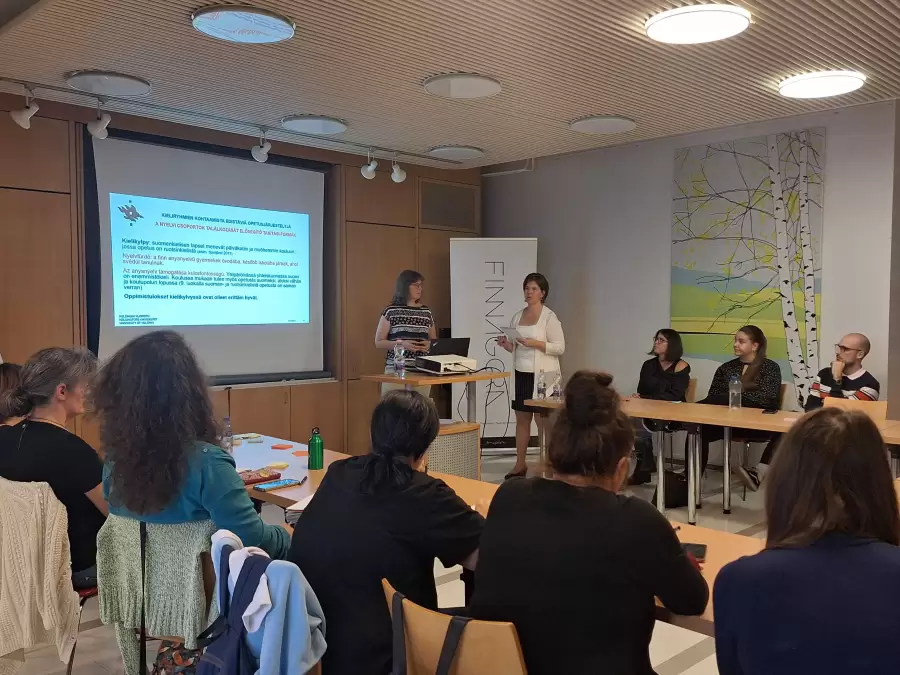The Finnish school system is renowned for its high quality around the world, but less so for its bilingualism. Namely, Finnish schools operate in both Finnish and Swedish, which provides a strong basis for a bilingual society. The language of instruction in Finland can also be Sámi, Romani, or sign language to serve historical minorities. In addition to this, multilingualism as a result of rising migration to Finland is an increasingly important part of the Finnish school landscape. More and more pupils have a multilingual background, and schools have taken this into account by offering support for learning Finnish alongside their mother tongue. The school system has started to develop support measures tailored to multilingual pupils, which strengthen both their Finnish language skills and their multilingual identity.
Last Friday, FinnAgora, with the support of the Svenska Kulturfonden, organised a seminar on minority languages for participants interested in Finnish schools and multilingualism. University of Helsinki researcher, Dr. Marjo Savijärvi gave a lecture on the role of Swedish in Finland, and how to strengthen multilingual learning. Teacher Gabriella Veres presented practical ways to support multilingual children in learning Finnish. Under her guidance, the participants were able to try out different games that support language learning in a fun and interactive way. Hungarian interpreter Klára Balicza took care of translating the seminar for the participants, showing how a multilingual audience was not an obstacle for mutual understanding.
The change in language teaching objectives reflects a broader societal shift, where cultural and linguistic diversity is seen as a strength, and the individual’s ability to function in a multilingual world is considered essential. In the past, the focus of language teaching was on learning a language almost perfectly, imitating native speakers. The goal was to master the language so well that the learner could blend seamlessly into the target society, like a spy, without their language skills being distinguishable from those of a native speaker. This was partly connected to the values associated with language proficiency, where accuracy and flawless pronunciation were key objectives.
Today, a different approach to language teaching is emphasised, focusing on functional language and interaction skills. This means that language teaching no longer considers native-level proficiency as the sole, or even primary, goal. Instead, the emphasis is now on the ability to use language appropriately in a variety of situations, even through mistakes. Interpersonal skills such as taking part in a conversation, self-expression and comprehension have become more important in today's globalising world.
The change in language teaching objectives has also had a significant impact on teaching methods in Finland. The emphasis on interaction and multilingualism has led to teaching strategies that favour communicative and participatory learning methods. Teachers encourage learners to use language in authentic situations and mistakes have become part of the learning process. This focus on multilingualism in language teaching is reflected in practices such as translanguaging, where learners use all their language resources in their learning. This means that learners can use different languages in parallel, according to the needs of the situation, rather than trying to keep them strictly separate. Supporting multilingualism is important because it deepens learning and enriches the linguistic and cultural competences of children and young people. When pupils have access to all their language resources, they learn more effectively and develop a wider range of thinking skills. Multilingualism also strengthens pupils' identity and self-esteem, as their full linguistic and cultural background is taken into account. This also creates a more positive classroom environment, as students learn to appreciate diversity and respect each other's backgrounds – which in turn fosters a sense of community and cooperation.
FinnAgora’s minority language seminar highlighted the importance of multilingualism in the Finnish education system. Lecturers Savijärvi and Veres emphasised how multilingualism enriches the learning experience and strengthens children's identity and cultural competence. In particular, learning through play and interactive methods proved to be an effective way of making language learning fun and inspiring. It is clear from this seminar that promoting multilingualism not only improves language learning, but also creates a sense of community and respect between people from different backgrounds. And this is an important lesson for a global world.
Text: Saaga Kaján

